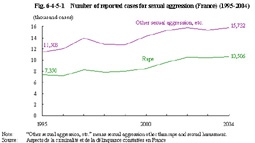| Previous Next Index Image Index Year Selection | |
|
|
1 France (1) Outline of sexual offenses
The main type of sexual offense in the Code Penal is sexual aggression (aggressions sexuelles). Sexual aggression is defined as "all sexual intrusion committed by violence, forcing, intimidation, or surprise attack" and divided into three categories, rape (viol), other sexual aggression (autres aggressions sexuelles; meaning sexual aggression other than rape), and sexual harassment (harcelement sexuel).
For offenses such as rape for children younger than 15 years of age, provisions for aggravated punishment are specified. (2) Trends in sexual offenses
Fig. 6-4-5-1 shows trends in the number of reported cases for sexual aggression over the last 10 years.
The number of reported cases for sexual aggression was generally on a rise between 1995 and 2002, but has remained flat since 2003. Fig. 6-4-5-1 Number of reported cases for sexual aggression (France) (1995-2004) (3) Outline of countermeasures against sexual offenses
Responding to the increase in sexual offenses, France has been developing a series of legislation since the late 1990s in order to prevent sexual offenses and protect victims, etc. Notable activities are as follows.
a. Socio-judicial surveillance on sex offenders (Suivi socio-judiciaire)
The "Act on Prevention of Sexual Offenses, Punishment, and Protection of Juveniles" in 1998 introduced a socio-judicial surveillance on sex offenders. The socio-judicial surveillance requires those convicted for certain sexual offenses, as a supplementary punishment or alternative punishment sentenced by adjudicating courts, to follow surveillance measures for preventing repeat offenses (meaning obligation to notify change of address, prohibition of having contact with specified persons, prohibition of engaging in professions or participating in social activities with chances to regularly have contact with juveniles, and so on) and support measures (meaning support for surveillance targets' social rehabilitation) during a specified period under supervision of an application judge (juge de l'application des peines). The socio-judicial surveillance sometimes includes an order for medical attendance (injonction de soins).
The term of the socio-judicial surveillance is calculated as from the date of release and shall not exceed 10 years for misdemeanor and 20 years for felony, in principle. However, after the revision in 2004, the term can be extended further in special cases. b. Judicial database on sex offenders (Fichier judiciaire national automatise)
The above-mentioned Act in 1998 also defines the establishment of a DNA database system collecting DNA obtained from biological evidence sampled in the course of investigation and DNA of persons convicted for certain sexual offenses. In 2001 and 2003, the scope of the subjects was expanded to persons for whom significant evidence existed to prove that they had committed certain sexual offenses.
The "Act for Adjusting the Judicial System to Progressing Crimes" in 2004 defines the establishment of a system to register persons convicted for certain sexual offenses into the judicial database on sex offenders. The judicial data system on sex offenders aims to prevent repeat sexual offenses and make identity confirmation of sex offenders easier. Sex offenders subject to this system are required to notify their address and changes thereof to judicial authorities by a specified period of time even after release. If they violate this, they are punished. Information on their personal identity, address, changes of address, etc. shall be recorded into the judicial database on sex offenders. c. Mobile electronic surveillance of sex offenders (Placement sous surveillance electronique mobile)
The "Act on the Treatment of Repeat Offenders" in 2005 defines that when an adjudicating court sentences a person who committed certain sexual offenses, etc. to imprisonment without suspension of execution of sentence for seven years or over along with the socio-judicial surveillance, if the person is an adult and medical examination confirms the hazardous nature of the person and finds it indispensable to prevent him/her from repeating offenses after release, the court may order the person to be placed under mobile electronic surveillance (meaning a measure to attach a transmitter to a part of the target's body so that judicial authorities can grasp his/her whereabouts) along with the socio-judicial surveillance.
The term of being placed under mobile electronic surveillance is for two years at the longest, however, extension can be admitted only once for an offender who committed a misdemeanor (for four years in total at the longest) and twice for an offender who committed a felony (for six years in total at the longest). |
